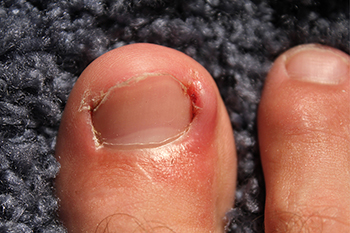Connect With Us
Blog
Items filtered by date: October 2024
Thursday, 31 October 2024 00:00
Heel Pain in the Morning?
Tuesday, 29 October 2024 00:00
Blister Prevention Methods for Active Lifestyles

Blisters are common nuisances that can hinder an active lifestyle, but several effective prevention methods can help keep them at bay. One of the most important strategies is wearing properly fitted shoes that provide adequate support and cushioning. It is important to choose footwear that accommodates the shape of your feet, reducing friction and pressure points. Using moisture-wicking socks can also minimize the risk of blisters, as they help keep feet dry and reduce friction. Applying blister prevention products, such as protective adhesive bandages or lubricants, can create a barrier between the skin and footwear. Additionally, gradually breaking in new shoes allows your feet to adapt, reducing the likelihood of irritation. Foot blisters can be uncomfortable, causing difficulty in completing daily activities. If you have developed a foot blister that has become infected, it is suggested that you promptly consult a podiatrist who can provide adequate relief, and educate you on additional prevention methods.
Blisters may appear as a single bubble or in a cluster. They can cause a lot of pain and may be filled with pus, blood, or watery serum. If your feet are hurting, contact one of our podiatrists of Advanced Foot Specialists. Our doctors can provide the care you need to keep you pain-free and on your feet.
Foot Blisters
Foot blisters are often the result of friction. This happens due to the constant rubbing from shoes, which can lead to pain.
What Are Foot Blisters?
A foot blister is a small fluid-filled pocket that forms on the upper-most layer of the skin. Blisters are filled with clear fluid and can lead to blood drainage or pus if the area becomes infected.
Symptoms
(Blister symptoms may vary depending on what is causing them)
- Bubble of skin filled with fluid
- Redness
- Moderate to severe pain
- Itching
Prevention & Treatment
In order to prevent blisters, you should be sure to wear comfortable shoes with socks that cushion your feet and absorb sweat. Breaking a blister open may increase your chances of developing an infection. However, if your blister breaks, you should wash the area with soap and water immediately and then apply a bandage to the affected area. If your blisters cause severe pain it is important that you call your podiatrist right away.
If you have any questions, please feel free to contact our offices located in Rockwall, Greenville, Dallas, and Sachse, TX . We offer the newest diagnostic and treatment technologies for all your foot care needs.
Tuesday, 22 October 2024 00:00
Finding Your Perfect Running Foot Strike

The way a runner's foot strikes the ground is fundamental to performance and injury prevention. Proper foot strike can enhance efficiency and reduce stress on the joints. There are three main types of foot strikes known as heel strike, midfoot strike, and forefoot strike. Heel striking, where the heel lands first, is common among many runners but can lead to increased impact forces. A midfoot strike, where the foot lands flat, promotes better shock absorption and a smoother transition. Lastly, forefoot striking, landing on the balls of the feet, can improve speed but may require stronger calf muscles. Each runner’s ideal foot strike varies based on individual biomechanics, running style, and fitness level. To find the best technique, it is advisable to focus on a natural stride, engage in strength training, and consider consulting a podiatrist. If you have sustained a foot or ankle injury while running, it is suggested that you contact a podiatrist who can provide treatment and guide you on effective running form.
If you have any concerns about your feet, contact one of our podiatrists from Advanced Foot Specialists. Our doctors can provide the care you need to keep you pain-free and on your feet.
Biomechanics in Podiatry
Podiatric biomechanics is a particular sector of specialty podiatry with licensed practitioners who are trained to diagnose and treat conditions affecting the foot, ankle and lower leg. Biomechanics deals with the forces that act against the body, causing an interference with the biological structures. It focuses on the movement of the ankle, the foot and the forces that interact with them.
A History of Biomechanics
- Biomechanics dates back to the BC era in Egypt where evidence of professional foot care has been recorded.
- In 1974, biomechanics gained a higher profile from the studies of Merton Root, who claimed that by changing or controlling the forces between the ankle and the foot, corrections or conditions could be implemented to gain strength and coordination in the area.
Modern technological improvements are based on past theories and therapeutic processes that provide a better understanding of podiatric concepts for biomechanics. Computers can provide accurate information about the forces and patterns of the feet and lower legs.
Understanding biomechanics of the feet can help improve and eliminate pain, stopping further stress to the foot.
If you have any questions please feel free to contact our offices located in Rockwall, Greenville, Dallas, and Sachse, TX . We offer the newest diagnostic and treatment technologies for all your foot and ankle needs.
Tuesday, 15 October 2024 00:00
Causes and Risks for Ingrown Toenails

Ingrown toenails develop when the nail grows into the surrounding skin, or when the skin grows over the edge of the nail. A primary cause of ingrown toenails is improper nail trimming, such as cutting the nail and rounding the edges instead of cutting straight across. This may result in the nail curling under and digging into the skin, which often results in pain as well as potential for infection. Other risk factors for ingrown toenails are wearing shoes that squeeze the toes, engaging in activities that put pressure on the feet, and having foot abnormalities like bunions or hammertoes. People with a family history of ingrown toenails, diabetes, or poor circulation are also more susceptible. Symptoms often include redness, swelling, and pain, and if untreated, can progress to infection. A podiatrist can assess and treat the condition, using techniques to relieve pain and in severe cases removing part of the nail or nail bed. If you have a painful or infected ingrown toenail, it is suggested that you schedule an appointment with a podiatrist.
Ingrown toenails may initially present themselves as a minor discomfort, but they may progress into an infection in the skin without proper treatment. For more information about ingrown toenails, contact one of our podiatrists of Advanced Foot Specialists. Our doctors can provide the care you need to keep you pain-free and on your feet.
Ingrown Toenails
Ingrown toenails are caused when the corner or side of a toenail grows into the soft flesh surrounding it. They often result in redness, swelling, pain, and in some cases, infection. This condition typically affects the big toe and may recur if it is not treated properly.
Causes
- Improper toenail trimming
- Genetics
- Improper shoe fitting
- Injury from pedicures or nail picking
- Abnormal gait
- Poor hygiene
You are more likely to develop an ingrown toenail if you are obese, have diabetes, arthritis, or have any fungal infection in your nails. Additionally, people who have foot or toe deformities are at a higher risk of developing an ingrown toenail.
Symptoms
Some symptoms of ingrown toenails are redness, swelling, and pain. In rare cases, there may be a yellowish drainage coming from the nail.
Treatment
Ignoring an ingrown toenail can have serious complications. Infections of the nail border can progress to a deeper soft-tissue infection, which can then turn into a bone infection. You should always speak with your podiatrist if you suspect you have an ingrown toenail, especially if you have diabetes or poor circulation.
If you have any questions, please feel free to contact our offices located in Rockwall, Greenville, Dallas, and Sachse, TX . We offer the newest diagnostic and treatment technologies for all your foot care needs.
Tuesday, 08 October 2024 00:00
Facts About Heel Spur Surgery

Heel spur surgery is often considered when conservative treatments fail to alleviate persistent pain caused by heel spurs. Heel spurs develop when calcium deposits form on the heel bone, leading to discomfort during walking or standing. Two common surgical procedures are inferior heel spur resection and posterior heel spur resection. The former targets spurs on the bottom of the heel, while the latter addresses spurs located at the back of the heel. Surgery is typically recommended for individuals experiencing severe pain that hinders daily activities or those who have not responded to medications or orthotics. However, certain individuals may not be ideal candidates for surgery, including those with underlying health issues or infections. If you have a heel spur, it is suggested that you are under the care of a podiatrist who can determine if heel spur surgery is right for you.
Foot surgery is sometimes necessary to treat a foot ailment. To learn more, contact one of our podiatrists of Advanced Foot Specialists. Our doctors will assist you with all of your foot and ankle needs.
When Is Surgery Necessary?
Foot and ankle surgery is generally reserved for cases in which less invasive, conservative procedures have failed to alleviate the problem. Some of the cases in which surgery may be necessary include:
- Removing foot deformities like bunions and bone spurs
- Severe arthritis that has caused bone issues
- Cosmetic reconstruction
What Types of Surgery Are There?
The type of surgery you receive will depend on the nature of the problem you have. Some of the possible surgeries include:
- Bunionectomy for painful bunions
- Surgical fusion for realignment of bones
- Neuropathy decompression surgery to treat nerve damage
Benefits of Surgery
Although surgery is usually a last resort, it can provide more complete pain relief compared to non-surgical methods and may allow you to finally resume full activity.
Surgical techniques have also become increasingly sophisticated. Techniques like endoscopic surgery allow for smaller incisions and faster recovery times.
If you have any questions please feel free to contact our offices located in Rockwall, Greenville, Dallas, and Sachse, TX . We offer the newest diagnostic and treatment technologies for all your foot and ankle needs.
Tuesday, 01 October 2024 00:00
Causes and Treatment of Foot Ulcers

Foot ulcers are open sores or wounds that typically develop on the bottom of the foot and can result from poor circulation or prolonged pressure. They are often linked to conditions like peripheral neuropathy, arthritis, and Raynaud's phenomenon. Peripheral neuropathy reduces sensation in the feet, making it difficult to detect injuries, while poor circulation from conditions like Raynaud's delays healing. Arthritis can increase the risk of pressure ulcers by altering foot mechanics. If untreated, foot ulcers can lead to severe infections, including gangrene, possibly resulting in amputation. Symptoms include swelling, redness, drainage, and pain surrounding the wound. Diagnosis involves physical examination and tests to assess circulation and nerve function. Treatment includes wound care, offloading pressure, managing underlying conditions, and sometimes surgery. Healing time varies, from weeks to months, depending on the ulcer's severity and the patient's overall health. If you have developed a foot ulcer, it is strongly suggested that you schedule an appointment with a podiatrist for treatment.
Wound care is an important part in dealing with diabetes. If you have diabetes and a foot wound or would like more information about wound care for diabetics, consult with one of our podiatrists from Advanced Foot Specialists. Our doctors will assess your condition and provide you with quality foot and ankle treatment.
What Is Wound Care?
Wound care is the practice of taking proper care of a wound. This can range from the smallest to the largest of wounds. While everyone can benefit from proper wound care, it is much more important for diabetics. Diabetics often suffer from poor blood circulation which causes wounds to heal much slower than they would in a non-diabetic.
What Is the Importance of Wound Care?
While it may not seem apparent with small ulcers on the foot, for diabetics, any size ulcer can become infected. Diabetics often also suffer from neuropathy, or nerve loss. This means they might not even feel when they have an ulcer on their foot. If the wound becomes severely infected, amputation may be necessary. Therefore, it is of the upmost importance to properly care for any and all foot wounds.
How to Care for Wounds
The best way to care for foot wounds is to prevent them. For diabetics, this means daily inspections of the feet for any signs of abnormalities or ulcers. It is also recommended to see a podiatrist several times a year for a foot inspection. If you do have an ulcer, run the wound under water to clear dirt from the wound; then apply antibiotic ointment to the wound and cover with a bandage. Bandages should be changed daily and keeping pressure off the wound is smart. It is advised to see a podiatrist, who can keep an eye on it.
If you have any questions, please feel free to contact our offices located in Rockwall, Greenville, Dallas, and Sachse, TX . We offer the newest diagnostic and treatment technologies for all your foot care needs.

